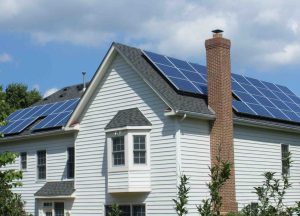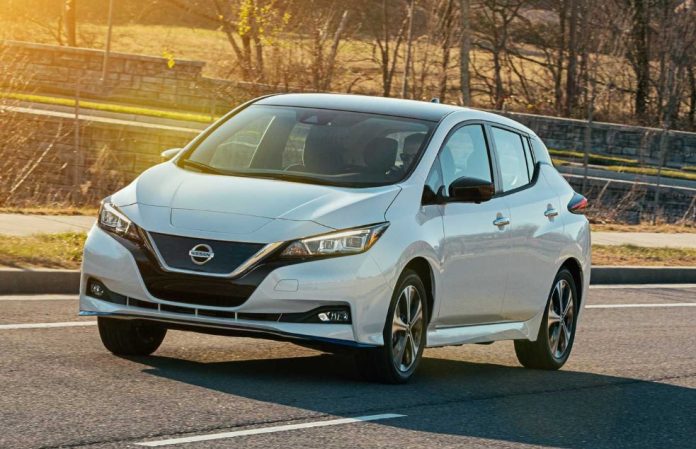Nissan is reportedly cancelling the Leaf, its “mass market” electric car. Which says a lot about the “mass market” for electric cars.
Especially in view of the fact that the Leaf is the most “affordable” electric car available in the United States, with a base price of “only” $28,895 (Chevy’s Bolt is next, with a base price of $31,000). That’s only $13,515 more than the base price of Nissan’s Versa, the Japanese automaker’s compact-sized economy sedan. Which is economical, by dint of not costing almost $30k to start, as the lowest-price version of the Leaf does.
And for that reason doesn’t have – never could have – a mass-market. 
How thick do you have to be to not grasp something as fundamental as that?
The analogy here is solar panels. How nice it would be to never have to pay a monthly utility bill again! Think of how much money you’ll save! But maybe some thought ought to be given to how much you’ll spend in order to “save” all that money . . . .
A solar array – and the necessary peripherals for a single family home – can easily cost $30,000. It is going to take a lifetime to “save that back” in the form of not having to pay the monthly power bill. Not including paying to repair/replace components – like batteries – along the way. 
But it’s not only that. Most people don’t have $30,000 burning a hole in their pockets – whether for a solar array and peripherals or an electric car like the Leaf. That means financing the cost, which adds to it – in the form of the interest on the loan. Interestingly, that interest is increasing – courtesy of the same interests that have devalued the value of the money people don’t have to buy things like $30,000 solar arrays or electric cars like the Leaf – are now raising interest rates, to combat the devaluation they caused.
Thus, the cost of money goes up as the value (buying power) of the money goes down.
It costs more – up front as well as month-to-month – to buy a nearly $30,000 Leaf than it does to buy a just over $15k Versa. Probably it will take longer, too – in order to make those monthly payments manageable. All the while – for all those months you’re paying – you aren’t saving.
And not only that.
Because you’re paying, you may not be able to pay for other things you may need that you may not know you’re going to need, such as something the house needs or your kids need. All those needs will just have to wait, because you haven’t got the money to pay for them.
This probably explains why Nissan lost money selling the Leaf.
Even heavily subsidized, as all EVs are – and not merely in terms of the massive federal tax breaks that have been used to make them more “affordable” – they still cost too much for most people to be able to afford and that makes them untenable as mass-market cars, which must be affordable in order for the masses to be able to buy them.
But how to make them more affordable – without subsidizing them?
EV batteries are dauntingly expensive, which is why EVs are unaffordable. An EV battery is akin – in terms of cost – to using gold to anodize a car’s wheels. It may be “cool” and even desirable, if that floats you boat. But it’s immaterial if you can’t figure out a way to pay for it.
And that is why they’ve figured that the way forward is to force people to pay more for gas, so as to make the electric car seem more “affordable.”
They are also making gas-engined cars more unaffordable, by forcing manufacturers to come up with dauntingly expensive technological “solutions” to meet ever-more-draconian regulations, such as the Biden Thing’s recent edict requiring all new cars to average nearly 50 miles-per-gallon, something that is only possible – given other regulations – by using hybrid technology. Which adds thousands to the price of the car, thus making the electric car seem more “affordable.”
But the fact remains that most people cannot afford any of this. Leaving aside whether they can afford to own a car with half the useable range that forces them to spend irrecoverable time waiting for and planning around recharge times. The base-priced Leaf has an advertised range of just 150 miles; if you want more range, it’ll cost you $32,400 for the “plus” version.)
The irony here is that the Leaf at least tried to be . . . economical.
Unlike Teslas and practically every other EV on the market – all of them touting their power and performance – the Leaf tried to tamp down the expense by not touting power and performance. It is not “ludicrously” fast. But even so, it still needs a massive battery pack in order to do what is understandably expected of any mass-market car – i.e., being capable of doing what any mass-market car can.
Specifically, being able to operate for several hours at highway speeds without conking out. With the AC or heater cranked.
The Leaf couldn’t do that, limiting its usefulness to short-range commuting. But when you can buy an economy car fully capable of doing that – and also of operating on the highway for several hours at 70 MPH – for a bit more than $15k, why would anyone willingly spend almost $30k for a Leaf that cannot do that?
Never mind. Look – a squirrel!
Nissan is going to spend a reported $18 billion on 15 new EV models.
“With EVs projected to be 40 percent of Nissan’s U.S. sales volume by 2030, we will offer a lineup of electric vehicles in a variety of segments to meet the growing demands of American customers,” says Nissan spokesman Brian Brockman.
The “growing demands”? He means, of course, the growing demands of the government, the force behind the force-feeding of these electric cars most people can’t afford.
It’ll be interesting to see what happens to Nissan – to all of them – when all they have to sell are cars most people can’t afford to buy.
. . .
Got a question about cars, Libertarian politics – or anything else? Click on the “ask Eric” link and send ’em in! Or email me at EPeters952@yahoo.com if the @!** “ask Eric” button doesn’t work!
If you like what you’ve found here please consider supporting EPautos.
We depend on you to keep the wheels turning!
Our donate button is here.
If you prefer not to use PayPal, our mailing address is:
EPautos
721 Hummingbird Lane SE
Copper Hill, VA 24079
PS: Get an EPautos magnet or sticker or coaster in return for a $20 or more one-time donation or a $10 or more monthly recurring donation. (Please be sure to tell us you want a magnet or sticker or coaster – and also, provide an address, so we know where to mail the thing!)
My eBook about car buying (new and used) is also available for your favorite price – free! Click here. If that fails, email me at EPeters952@yahoo.com and I will send you a copy directly!












Eric,
I thought about installing a solar system here too. My home’s small, so it wouldn’t be $30K, but it would still be expensive; it would be about $15K-$20K to do my house. Since my electric bill is low (I’ve never paid over $95, even during the dog days of August), I’d DIE before I could recoup the money! Even though that leaves me tied to the grid, I got a small generator to save my food and what not. For me, solar simply does not make sense…
Marky,
Why so much? Again, are we talking about installers? Because DIY, it shouldn’t cost anywhere near that much, especially given your electric bill, unless your electric utility company are angels, which is unlikely. What’s your daily electric consumption in August?
“A solar array – and the necessary peripherals for a single family home – can easily cost $30,000. It is going to take a lifetime to “save that back” in the form of not having to pay the monthly power bill.” -Eric
If you’re paying that much, you’re being ripped off. Sadly, if you’re paying that much, it’s likely because of the vampiric installers, and you’re probably not even paying for batteries.
I have ~8kW worth of solar panels, for which I’ve paid $2,200. Yes, the peripherals, and particularly the batteries will cost more money. 19kWh of LiFePO4 batteries costs about $5500 these days. But the total cost for a home solar installation (done yourself, of course) shouldn’t be too much more than $10. Even WITHOUT “incentives”, which I’ll never take, because no one owes me anything and I don’t want the gov’t to know what I’m building.
The way our electric utility charges, I estimate I could’ve paid off the cost of an entire solar installation in ~6 years. That leaves, likely, at least 4 years free use on the batteries and ~20 years free use on the panels. Mileage will vary on the other equipment, but it’s not that expensive. If we could easily buy NiFe batteries, they would likely last the rest of our natural lives.
There are also better ways to use solar to heat. Consider a solar-thermal system, or even “land-ship” design. Also, heat-pumps can be much more efficient if fed air from earth tubes.
More economic downside – if you’re installing solar on your roof for that EV charge at home better check your roof warranty. For some reason the neighbor checked with the roofer that did their new asphalt shingle roof last fall. He told her the solar install on the roof voids the new roof warranty. Oops!
They’re proceeding with a ground based install now. The little white marker flags have moved away from our property line, think the neighbor heard my loud daughter complaining “Dad those ugly things will be right next to you!” Eh eh eh.
Are car makers intentionally committing economic suicide? Their only hope of surviving is standing up to the regulatory bureaucracy. As is historically the case, you don’t win by kneeling.
There’s a fine line between going Galt and committing economic suicide.
Unfortunately I think it’s the latter, in this case.
Time will tell. I hope it doesn’t drag me down with it (I work in the industry so the more they cut the number of builds the more we feel it).
They are in bed with FedGov. And our current fedgov is nuts. It must be that they know, once they get production up enough, fedgov will start to add significant added cost/taxes to ICE ownership.
We have a little hope in the recent Scotus ruling that basically says the EPA can’t regulate or something like that. So hopefully lawsuits start coming out against EPA regs.
Lots of Luck Nissan…… “With EVs projected to be 40 percent of Nissan’s U.S. sales volume by 2030”.
Trying to get people to buy electric from brands like Nissan is even more of a stretch than brands like Honda or Toyota. Most of Nissan’s gas lineup is of the “also ran” variety so their electric lineup would likely be even more so.
The present percentage of new car sales that are electric in 2022, about 1%. Been about 1% for at least the last 15 years. So how are they going to get to 40% when they just cancelled the cheapest electric car? So instead of one poor selling model they will have 15 poor selling ones?
Another untold story, almost half of the Chevy Bolts from the 2019 and 2020, models years are still on dealer lots unsold.
I think it is going to be 40 percent of a much smaller number of builds, if it comes to that.
Too many people don’t want g to gem and/or can’t afford them.
Why do car manufacturers stop selling a particular model car? Poor sales has to be the answer. In my opinion, the demand for electric cars is limited, and once saturated, electric cars will be hard to pedal.
Here are the Leaf’s USA sales figures:
https://www.goodcarbadcar.net/nissan-leaf-sales-figures/
2010 19
2011 9,674
2012 10,297
2013 22,610
2014 30,200
2015 18,442
2016 14,006
2017 11,230
2018 14,715
2019 12,365
2020 9,559
2021 14,237
2022 7,623
—————
Honda produced the hybrid Insight in 2,000, rated the highest EPA MPG of 70 mpg. You’d think they would sell like hotcakes. Nope.
https://en.wikipedia.org/wiki/Honda_Insight#Sales
So why oh why can’t they sell really fuel efficient cars? I think that people who can afford new cars are not so concerned about fuel economy over other features, like seating and comfort.
Honda retired the first Insight model when sales for all of North America were only 500 units per year.
I have been very interested in owning one, since they are rated so high in mpg, but I can not get myself to buy a car that I can’t work on cheaply.
“electric cars will be hard to pedal.”
You bet they are hard to pedal when the battery goes flat. That makes them hard to peddle.
Beat me to it ERLE after the battery dies the alternative will be to pedal, like Fred Flintstone’s car. Yabba dabba don’t.
after the battery dies the alternative will be to pedal, like Fred Flintstone’s car. Yabba dabba don’t.
Let’s do some math, subtract the initial capital cost of a Nissan Leaf vs. Nissan Versa:
https://www.edmunds.com/nissan/leaf/2022/msrp/
https://www.edmunds.com/nissan/versa/2022/msrp/
$28945 (Leaf base) – $16,675 (Versa base) = $12,270
which checks with Eric’s number:
“That’s only $13,515 more than the base price of Nissan’s Versa”
Using Eric’s $13,515 divide $5 a gallon gasoline
I can burn 3160 gallons of gas for free until I equal the Leaf cost.
Checking EPA mpg for 2022 Versa
https://www.fueleconomy.gov/feg/bymodel/2022_Nissan_Versa.shtml
35 mpg combined
So 3160 gallons x 35 miles/gallon = 110,000 (free) miles
—————-
So who in the hell would buy a Leaf with a 50 mile range and a battery replacement cost of $5,000?
Then we have the resale value after 10 years.
The Versa WILL be worth something, like $5,000 to 10,000 but the Leaf may not be worth much. No one wants to shell out thousands for a used electric car that might need a new battery.
A used Nissan economical gasoline sedan is in great demand.
quoting internet: “A replacement battery for a Nissan Leaf will cost between $5,500 and $6,500.”
I am surprised they sold any, but like WC Fields said there’s a sucker born every minute.
In my not so humble opinion, these electric cars are a “flash in the pan”, gimmicks for Libtards who have way to much money, idiots that want to virtue signal, and like cryptos they are all going to zero very fast.
Yukon Jack,
Good show! Back in the day, what you just did was what we use to do to qualify if an energy option was to be employed on a new building project to see if it were economically viable. My basic rule of thumb was you needed to recover the added cost to implement a new system (heat recovery chiller, etc) in 5 years or less or it was not viable. If you don’t start pocketing savings after 5 years you never recover enough $ to get above a comparative return from 10–15-year interest or relatively safe 4% return in market (bonds use to be safe return of value). About the 15 year was where increased maintenance/replacement costs would kick in and you would need the continued savings rate below 5 years to build back the future expense down the road.
Today if you showed the public how electric cars are not viable would result in possible federal charges for miss-information and possible links to January 6th. God save our country.
YJ,
There’s a simpler way to do the math. $28,945-$16,675=$12,270. $12,270/$5=2,454 gallons of gas. For city mpg, we’ll assume 25 mpg. 25*2,454=61,350 miles of driving. Assuming 15,000 miles average per year, that means it would take you over four years to recoup the purchase price of the Leaf. And that’s just for the BASIC Leaf! If you get the “Plus” version with the 225 mile range, then it’ll take you over five years to recoup the difference in purchase prices. Even so, even worst case scenario, the Versa still offers 250+ miles of range for about half the price…
MarkyMark, You also need to run the cost of KW spent on the electric transportation device (not a car) during the same period to make your comparison apples to apples.
they don’t want us moving around AT ALL
herd those conservative rural rednecks into compact cities, bugs & Bill Gates mystery meat on the menu
Seems like there is another EV Conflagration as often as you write about them, Eric!
https://www.youtube.com/watch?v=Le6KNI9YsH0
Maybe Nissan cancelled the “Leaf” before it, too, goes up in smoke, lol!
So will we reach a point where the govt need to increase subsidies (at least to the poorest) for EVs, thus expanding currency inflation? [We all know the $$ will be printed]
Which will in turn keep things expensive?
We aren’t there yet but could be.
Though I bet election fears get in the way of $5 gas for too much longer, reducing the incentive for EVs
The flip side is a way has been found to keep you a debt slave.
The real leaf numbers…..
Lots of lies….
ice vehicles burn fuel in the vehicle so it is hard to hide what the fuel consumption is, with EV’s the fuel is burnt back at the power station, so it is easier to hide/lie about how much fuel was burnt to generate the electricity, this is never discussed and is lied about/denied/concealed all the time….lol….24/7 liars…..
What they wanted: (these numbers are almost exactly what the Leaf is advertised to get)
The target fuel economy EV manufacturers are trying to get is to get 3.6 mile range for every kwh or using 27.77 kwh to go 100 miles (.2777 kwh per mile) = 125 mpg
125 mpg is based on electricity just coming out of a wall plug, in reality 3.20 gallons of fuel are burnt to generate the electricity in the power station). = 31.25 mpg
What they got: (this is what you will get driving the leaf in the real world)
What test drivers are actually getting driving in the real world driving EV’s is they are getting 2.4 miles of range for every kwh or using 41.66 kwh to go 100 miles. (.4166 kwh per mile) = 83 mpg
(83 mpg is based on electricity just coming out of a wall plug, in reality 4.80 gallons of fuel were burnt to generate the electricity in the power station = 20.8 mpg).
So to end up with 41.66 kwh of electricity which is equivalent to 1.20 gallons of gas to push the EV 100 miles down the road 4.80 gallons of fuel were burnt to generate the electricity in the power station, remember net 25% efficiency. 100 miles using 4.80 gallons = 20.8 mpg,
So in reality the Leaf is getting about 20.8 mpg….lol
The cheaper nissan Versa gets 35 mpg…lol
The Versa costs far less, has a better resale value (depreciates less), it costs less to maintain it has a far longer life span, it doesn’t have a fire bomb lithium battery so is safer…
One reason the Versa gets better fuel economy is it weighs 2599 lb, the Leaf weighs 3516 lb, almost 1000 lb more, probably mostly in the battery.
These liars say a 3516 lb car gets better fuel economy then a 2599 lb car, this is impossible, they are lying…..the only way this can happen is with lies or fairy dust…lol
20.8 mpg….lol…..these EV’s use more fuel so pollute more then ice vehicles
most new gas or diesel ice cars get better fuel economy, cost way less, use far fewer resources to manufacture, don’t have lithium fire bomb batteries, last three times as long as EV’s….
NOTE:
Thermal efficiency of power plants using coal, petroleum, natural gas or nuclear fuel and converting it to electricity are around 33% efficiency, natural gas is around 40%. Then there is average 6% loss in transmission, then there is a 5% loss in the charger, another 5% loss in the inverter, the electric motor is 90% efficient so another 10% loss before turning the electricity into mechanical power at the wheels.
33% – 6% – 5% – 5% – 10% = 25% efficiency for EV’s. In very cold weather EV’s are 12% efficient
Plus the cost of the battery, which is huge, you have to store the electricity in the very, very expensive battery, that is the killer for EV’s right there, the expensive, rapidly wearing out battery.
the tesla $22,000 battery is used up, worn out in 100,000 miles. this works out to $22.00 per 100 miles it is costing you for the battery. Remember to add on the battery cost.
These liars say a 3516 lb car gets better fuel economy then a 2599 lb car, this is impossible, they are lying…..the only way this can happen is with lies or fairy dust…lol
they are getting away with this, lying to people, advertising 125 mpg, the biggest lie ever told….there should be a lawsuit…..start one, maybe they will give you $100,000 just to shut you up…lol……..nobody is calling them out on this lie…
Transporting lithium batteries….
this is why it takes longer to get your lawnmower, pressure washer these days…
NOTE: lithium batteries can only travel via Haz Chem or ADR due to risk of this.
ADR is French for “European Agreement concerning the International Carriage of Dangerous Goods by Road” the governance of international transport of Dangerous Goods.
How are they shipping these 1000+ EV batteries?…lol
Driving around with a fire bomb lithium battery under your car….maybe you should have this kit in your car…lol:
https://www.hazchemsafety.com/product/full-adr-ppe-driver-kit/
TRANSPORTING LITHIUM BATTERIES – DO YOU KNOW WHAT TO DO?
Lithium Batteries are fully regulated Dangerous Good and must follow the Transportation of Dangerous Goods Regulations for all shipments by Air, Ground and Marine. Lithium batteries are classified as Class 9, Miscellaneous Products, Substances or Organisms.
Shippers and importers of lithium batteries must meet shipping requirements set out in the TDG Regulations and declare package contents to postal carriers, couriers or transport companies. If damaged, Lithium Batteries can pose a number of risks for all parties, including fires, explosions and off-gassing.
ATTENTION: It is forbidden to ship damaged, defective, recalled or
NOTE: recycled lithium batteries by aircraft.
This applies whether or not these lithium batteries are contained in equipment
Following a United Parcel Service plane crash in Dubai, (lithium battery fire causes plane crash), the FAA acknowledged the potential danger of transporting lithium batteries due to the risk of cargo fires. As of January 1, 2008, the Department of Transportation (DOT) no longer allows loose lithium batteries in checked luggage.
The theory is that with spare batteries in the passenger compartment (instead of in the cargo hold), flight crews can better monitor the conditions and access fire extinguishers if a fire does occur. Pretty funny you can’t put out lithium battery fires…..
https://gemc.ca/blogs/news/transporting-lithium-batters-do-you-know-what-to-do
There are all sorts of screwy covidian like rules for the transport of Li-Ion Batteries.
If it’s an approved pack design then it can be transported in the device it powers with little or any regs. If it’s not approved it has to be in a metal container filled with vermiculite. Thankfully it’s been many years since I had to deal with such things.
The Bolt is actually going to start at $25,595 for the 2023 model. Which is probably all it’s really worth anyway.
But I think the real problem with the Leaf was that it was embarrassingly ugly. And the Bolt is embarrassingly dorky. You’d have to be an EV enthusiast to even consider buying something like that.
Actually $26,595 for the 2023 Bolt. Whatever.
Solar can be affordable if you have gas heat and no air conditioning. My 6 kW system netted (after the various “incentives” AKA tax dodges), around $9K. That should pay back in under 10 years. However I looked at it as bringing forward future payments, not as an investment or a way to save a bunch of money (aside from a massive reduction in income tax last year). I also made provisions to include a backup/time-shifting battery, although because of LG’s recall and leaving the battery market, that didn’t happen.
Note that I didn’t borrow to pay for the system. Financing would have greatly pushed out the “payback” and wouldn’t have the intended effect of bringing forward future payments. Instead of paying my electric utility I would have been paying a bank. And if I were to stop paying the bank they’d put a lein on my home.
‘And if I were to stop paying the bank they’d put a lein on my home.’ — ReadyKilowatt
Most solar lenders do this at the time of purchase:
‘A UCC-1 is a filing by the solar lender or bank that indicates their legal right to repossess all solar equipment in the event that you fail to keep up with your payments on the solar lease and in some cases solar loans. This ensures that the asset of the lender [the solar panels] remains protected until paid for in full.’
https://www.positiveenergysolar.com/blog/2021/april/will-investing-in-solar-result-in-a-lien-on-my-h/
Sales reps don’t tell homeowners that in a future sale, if a prospective buyer balks at assuming their solar loan, the homeowner will have to pay it off in a lump sum out of their sales proceeds, to satisfy the lien.
That’s a weak bargaining position to be in, versus both the lender (who could try to jack the interest rate as a condition for a buyer to assume the loan) and the buyer, who may well offer only 10 or 20 cents on the dollar for depreciated solar equipment.
Hi Jim
Solar panels are great…lol
Solar panels:
The main problem with solar arrays is the chemicals needed to process silicate into the silicon used in the panels. To make pure enough silicon requires processing it with hydrochloric acid, sulfuric acid, nitric acid, hydrogen fluoride, trichloroethane, and acetone. In addition, they also need gallium, arsenide, copper-indium-gallium- diselenide, and cadmium-telluride, which also are highly toxic. Silicone dust is a hazard to the workers, and the panels cannot be recycled.
Solar panels can’t be recycled…..what will they do with them (and wind turbine blades)? throw them down old mine shafts like nuclear waste?…..lol..
solar panels are toxic. They sterilize the ground they sit on. Birds that fly over a solar farm are roasted mid-flight.
Have you researched the temperature directly above a solar farm?? These farms have been accused of creating warming in the regions around them.
The alarmists will always show you pictures of solar panels on green grass – which have to taken as soon as the panels are installed. They leach cadmium and other toxic chemicals and sterilize the soil. Just try to find anything growing under a solar farm that has stood for a few years.
Good thing is, used market will always be available for people who need a “new” car in the future but don’t want some rolling crematorium Uncle is shoving down our throats like all his other radical views
Even if prices never settle down, I’d pay for some reliable old sports car over a “new and improved” whatever will be available thanks to Uncles Man-dates in the future
hi Zane
I have always said the best bargain in the world is a used car. For example I bought a 1980 Porsche 924 Turbo, everything is stock, no rust, for $1900, 6 years ago, the replacement new price in today’s dollars is about $80,000. It is now worth maybe $20,000….. if in very good condition (in Europe maybe $30,000). Why buy new?
‘A solar array – and the necessary peripherals for a single family home – can easily cost $30,000.’ — eric
And it’s mandatory on new houses in California. They assumed that the federal solar tax credit, which sunsets at the end of 2023, would subsidize the cost.
By refusing to renew it, Joe Manchin has delivered a gut punch to Commiefornia.
Forced to pay full freight for absurdly expensive solar arrays, even more Californians of modest means will conclude that they never can afford a house there.
They can either head east to freedom … or march on Sacramento and burn it down (mostly peacefully, of course).
I think I kind of like this Manchin character.
Hi Jim
And it’s mandatory on new houses in California.
that is a great idea, they will pollute the land your house is built on, this green bs is insane…lol….make sure you have no plants or lawn……
The main problem with solar arrays is the chemicals needed to process silicate into the silicon used in the panels. To make pure enough silicon requires processing it with hydrochloric acid, sulfuric acid, nitric acid, hydrogen fluoride, trichloroethane, and acetone. In addition, they also need gallium, arsenide, copper-indium-gallium- diselenide, and cadmium-telluride, which also are highly toxic. Silicone dust is a hazard to the workers, and the panels cannot be recycled.
Solar panels can’t be recycled…..what will they do with them (and wind turbine blades)? throw them down old mine shafts like nuclear waste?…..lol..
solar panels are toxic. They sterilize the ground they sit on. Birds that fly over a solar farm are roasted mid-flight.
Have you researched the temperature directly above a solar farm?? These farms have been accused of creating warming in the regions around them.
The alarmists will always show you pictures of solar panels on green grass – which have to taken as soon as the panels are installed. They leach cadmium and other toxic chemicals and sterilize the soil. Just try to find anything growing under a solar farm that has stood for a few years.
Somebody should confront them with this info and ask them…how stupid are you?…lol…)or how bribed are you by the suppliers)….
Must be why schools teach new maff instead of basic arithmetic. So the Versa has a 10.8 gallon gas tank – assuming the driver fills it up 10 gallons a week at $5 a gallon, $2600 per year in gas cost. Then, assume 75 kW for the Leaf to go the same roughly 300 miles the Versa will go on 10 gallons, at 10 cents per kWh, is about $400 per year in electric cost to drive the Leaf. 2600 – 400 = 2200, divided into 13,500, you are talking about 6 years to recoup the gas savings. Right about the time the battery pack craps out or well beyond the point when most people buy a new car. But hey, save at the pump, never realizing that the pump savings are just rolled up – and then some – in the monthly car payment.
Not to mention the enhanced insurance on EVs, the increased cost to maintain tires, etc., and the cost to upgrade home wiring to charge without an orange extension cord. And the incalculable opportunity costs.
But if that’s your thing, have at it.
Hi BAC
NOTE: in the U.S. where Superchargers charge you by the kWh things have gone haywire. A Tesla owner shared on Twitter the Supercharging rates from the Los Angeles area and indicated that they roughly doubled in the past years. To be sure, the $0.58/kWh rate is for the peak hours from 11 am to 9 pm, with half that outside this interval. Twitter users across the U.S. have indicated similar rates, with averages of $0.40 becoming the norm.
If you charge at super chargers or their equivalent the cost per kwh can be $0.40 per kwh so instead of $400 per year it would be $1600 per year for electricity to recharge, $2600 – $1600 = $1000 savings per year so now it takes 13.5 years to recover the price difference.
If you didn’t have the $13,500 tied up in the EV you have in the past been able to get 7% return per year in investments that is another $910 per year lost, so now the savings is only $90 per year so it will take 150 years to break-even buying the EV.
You have to include the battery replacement cost after around 9 years = $5000 = another $555 per year hidden cost, so instead of saving $90 per year it actually costs $555 – $90 = $465 more per year to drive/own the EV Leaf.
There is more costs, EV’s depreciate faster then ice vehicles,
Electric cars depreciate over two times faster than their internal combustion engine counterparts,
ice cars used to depreciate 10% as soon as you drove onto the street, then 15% per year from then forward, if EV’s depreciate twice as fast as ice vehicles, there is another $1000 (or a lot more then $1000) per year hidden cost.
So add another $1000 onto the $465 loss per year = $1465 per year loss owning the EV (don’t forget you already lost $13500 because of the price difference, which is gone, not recoverable).
https://crestlineautotransport.com/blog/electric-vehicle-depreciation/
There is another cost to EV’s, more expensive service
Study: EVs Cost More to Repair,
Service Advantage Goes to Gas
Service visits – those that involve diagnosing and repairing a problem – were a different story.
During the first three months of ownership, EVs were 2.3 times as expensive to service as gasoline-powered cars. At the 12-month mark, repair costs were about 1.6 times what owners of gas-powered cars paid.
It’s Not Parts. It’s Labor
Why the extra expense?
Because EV problems took longer to diagnose and repair. Technicians spent 1.5 times as many hours working on EVs as they did on gasoline-powered cars. And those technicians cost more, to begin with. Working on EVs requires additional certifications most mechanics don’t have. Those that do charge about 1.3 times the average hourly rate.
https://www.kbb.com/car-news/study-evs-cost-more-to-repair-less-to-maintain/
Repairing Ev’s is a big problem now, nobody knows how to fix them, they are very dangerous to work on because of the very high voltage (lots of places won’t work on them for that reason), they are very complex compared to an internal combustion engine, they are new technology so people don’t understand them, so very difficult to diagnose. If you break down in L.A. there probably will be a repair place that can fix your EV, if you are in a small town somewhere good luck getting it fixed.
Maybe too, people might actually be waking up to the depreciation problem with these turds, now that they’ve been around long enough to be a more common sight on the used market. Maybe they’re figuring out that the car they paid $13K more for than what a Versa would’ve cost them, is worth even less than the cheap Versa after a few years, because the closer ya get to battery replacement time, the closer you are to throwing the stoopit thing in the dumpster; Not to mention that if anything goes wrong with the complex electronics once it is out of warranty, not only will it cost a large fortune to have it fixed…but just try finding someone other than the stealership who knows how to fix it….assuming your model is even still supported by the manufucturer- who seem to have a nasty habit of dropping these things like hot potatoes before they are even old.
So even if one can overcome the big premium they’ve paid for the virtue-mobile over the cost of an ICE car in fuel savings….those savings will just b e eaten up when it’s time for battery replacement, or to throw the thing in the dumpster or sell it for $1500 to some other foll at end-of-life.
Ever listen closely to those ads for home solar panels? They always say you can get their home-solar energy system at no cost, (at the time of installation). That part in parentheses is always whispered quietly and quickly, practically swallowed, compared to everything else they are shouting at you. Of course, the first thing they shout at the beginning of the ad is “Why isn’t every home in the U.S. powered by solar energy!!!???? To which, any rational individual should shout back, “because it’s too fucking expensive!”, as well as, “if it were affordable, practical, and even remotely possible, you wouldn’t ask that stupid question, because we aren’t stupid and would have already fucking done it!”
As many times as I have said no to a scam, I really should be a fucking millionaire by now, LOL!
GTC one compay around here will install a solar system for “free” on your rooftop. But when you look into the deal, you’re basically just giving them access to your roof over the next 20 years and paying them for your electricity.
I might be willing to rent out my roof space to them but it is far too valuable to give away for nothing!
I’m not surprised in the least, there is ALWAYS a catch22 somewhere.